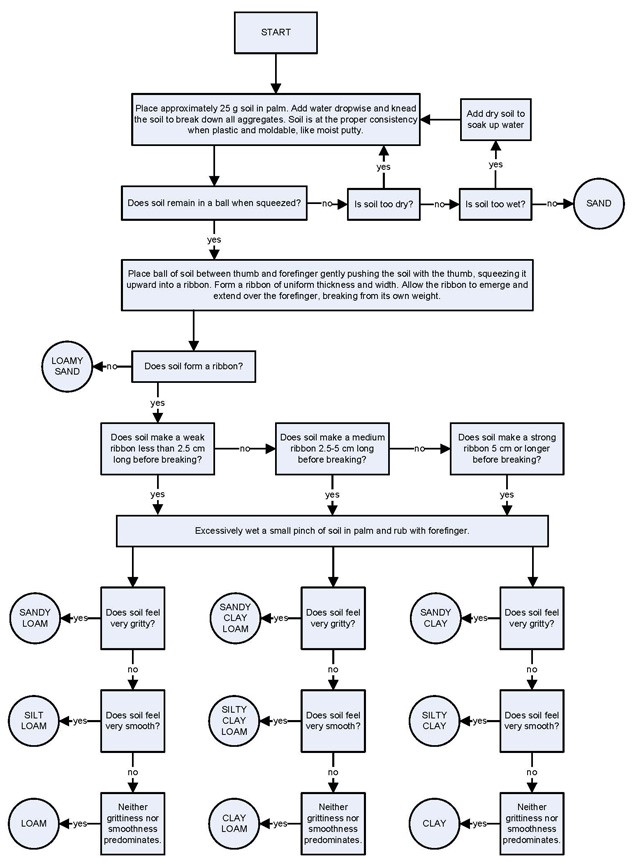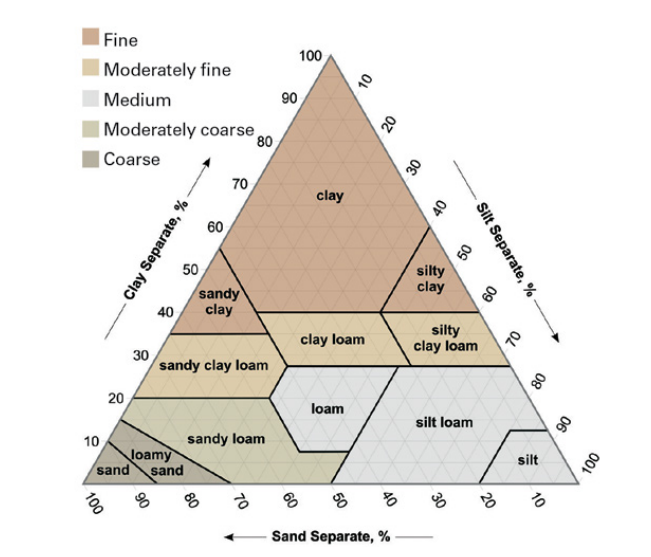Soil Texture
Amber Anderson; Lee Burras; Gerald Miller; and Erin Smeltzly
Texture of the A Horizon

The texture of the soil horizons, particularly the A horizon, has a strong influence on soil productivity and management requirements. In general, sandy soils are easy to cultivate but are low in fertility. Soils with high clay content are usually fertile but may be more difficult to manage because they are sticky and plastic when wet and hard when dry. High clay-content soils are likely to have lowered permeability to air and water and high resistance to root penetration. The structural strength of aggregates and potential erosion of the soil are also greatly dependent on texture.
The proportions of sand, silt, and clay in soil determine its texture. Each soil horizon may have a texture slightly different from any other. However, texture variations within an A horizon are usually small enough to permit it to be considered as a unit even if A and E horizons are both present.
Higher resolution flow chart here: USDA. 2022. Guide to texture by feel. https://www.nrcs.usda.gov/sites/default/files/2022-11/texture-by-feel.pdf

Sand, silt, and clay are mineral grains that are defined on the basis of size, (see Table 1). Sand grains are .05 mm to 2.0 mm in diameter — large enough to be seen and to impart a gritty feel to the soil. Materials larger than 2 mm (gravel/rocks, etc.) are excluded from textural determinations. Silt particles are .002 mm to .05 mm in diameter. These particles produce a smooth “floury” feel. Clay particles are less than .002 mm in diameter — small enough to make the soil sticky and plastic when wet or hard when dry. A mixture of sand, silt, and clay that exhibits the properties of all three materials about equally is called loam. Clay properties tend to be strongly expressed compared to the amount present. For example, an average loam contains about 40 percent sand, 40 percent silt, and 20 percent clay (Figure 3).
|
Soil Separate |
Diameter |
Particles per gram* |
Identification |
|---|---|---|---|
|
Sand Very coarse sand Coarse sand Medium sand Fine sand Very fine sand |
2.0-0.05 2.0-1.0 1.0-0.5 0.5-0.25 0.25-0.10 0.10-0.05 |
0 90 720 5,700 46,000 722,000 |
Can see individual grains, feels gritty |
|
Silt |
0.05-0.002 |
5,776,000 |
Feels smooth like talc or flour |
|
Clay |
< 0.002 |
9,260,853,000 |
Sticky when wet, hard when dry |
The terms sand, silt, clay, and loam are used in various combinations to name 12 soil textural classes. The more dominant particle size at the end, with modifiers placed in front. For example, a loamy sand has mostly sand, but up to 30% of another particle size. Note that a soil with 33% of each is not a loam, or mix, but a clay loam. Textural classes are named by influence, not strictly percentages of particles.
A simpler classification containing five textural groups will be used for the contest. The five groups are called coarse, moderately coarse, medium, moderately fine, and fine. These textural groups include one or more of the textural classes as shown in Figure 4. Soil texture is determined in two different ways. The actual percentages of sand, silt, and clay can be determined by a laboratory procedure called a mechanical analysis. In the field, however, it is necessary to estimate the soil texture by feeling it with the fingers. This skill can be developed with practice and will be used in the contest. Contestants should work with samples of known texture to gain proficiency.
Moisten a sample of the soil (about enough soil to fill a teaspoon) with enough water to make it as plastic (formable like putty or modeling clay) as possible. If the soil initially becomes sticky, it is too wet. Knead the soil thoroughly between your thumb and fingers. People experienced at estimating texture by feel keep one hand clean for writing while using the other hand to knead the soil.
Texture of the B Horizon
The texture of the B horizon influences other properties such as structure, permeability to air and water, resistance to root penetration, and strength for supporting construction and buildings. B horizon characteristics are important because the A horizon is seldom thick enough to meet all the needs of growing plants.
As a result of clay movement, the B horizon usually contains more clay than the A horizon. Most of the transported clay is present as coatings on sand and silt grains, on soil structural units, and on the inside of soil structural units. The material should therefore be kneaded well in the process of determining the texture of the B horizon. The methods of determining the texture and the classes to be used are the same for the B horizon as for the A horizon. If 24 inches or more light-colored sediments overlie a buried A horizon, the texture of the buried A horizon will be determined by the contestant if the buried A horizon extends to the full depth of the exposed profile. If the buried A horizon does not extend to the full depth of the exposed profile, the horizon will be ignored as described in the previous section discussing horizons.
- Texture is determined by the proportions of sand, silt, and clay particles within a soil.
- Rocks, gravel, or fragments larger than 2.0 mm are excluded from textural determinations.
- Sand grains are .05 mm to 2.0 mm in diameter making them large enough to be seen and to impart a gritty feel.
- Silt particles are .002 mm to .05 mm in diameter and have a smooth “floury” feel.
- Clay particles are less than .002 mm in diameter. These particles are small enough that they make the soil sticky and plastic when wet or hard when dry.
- The five textural groups that will be used in contest include: coarse, moderately coarse, medium, moderately fine, and fine.
- Soil texture can be determined by using a laboratory procedure called mechanical analysis or by using the field method, known as the “ribbon test.”
- B horizons occur in the subsoil position and affects water, air movement, and plant growth. The color is a good indicator of the air and water relationships in the soil. The B horizon usually contains more clay than the A horizon.
- Redox features are found within soils that have alternating wet and dry internal conditions. Redox indicates the presence or absence and concentration of various compounds of iron and manganese in the soil due to the degree of oxidation and hydration.
- Henry D. Foth, Fundamentals of Soil Science (New York: Wiley, 1978), p. 26. ↵

